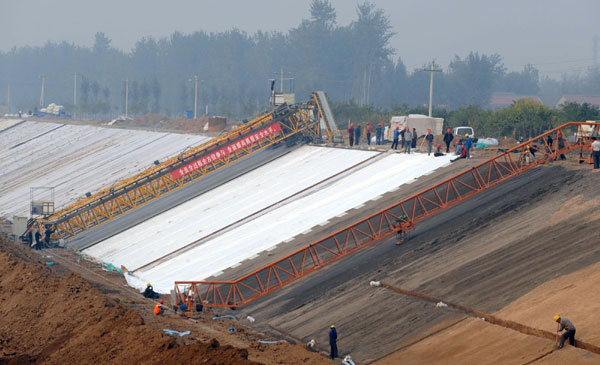As US debates, China acts
Updated: 2010-12-21 11:22
(Agencies)
HANGZHOU-- Gravel-laden barges glide past the willow-fringed banks of the Grand Canal, plying a trade route built 2,500 years ago to bring grain from China's fertile south to its rulers in the north.
Now the 1,800-kilometer (1,125-mile) passage is part of an even grander scheme: a US$150 billion plan to bring water from the mighty Yangtze River to the parched north in what is the world's most expensive infrastructure project.
Increasingly, a group of rising economies - from Brazil to the United Arab Emirates - is building the gigantic projects that once were mainly the pride of the US, Western Europe and Japan. America's Hoover Dam made headlines in the 1930s; today, it is China's Three Gorges Dam.
Just as railways and highways transformed America into an industrial superpower, the 21st-century building boom is laying the foundations for these rapidly growing economies to join the top leagues.
"Projects are getting bigger and bigger in the developing economies, not only to cater for demand, but also in anticipation of future growth," says Wilfred Lau, director at the engineering and design consultancy Ove Arup & Partners in Hong Kong.
Half of the 30 most expensive projects globally are in China, Brazil, the Middle East and other parts of the developing world, according to a list compiled by The Associated Press. A dozen are in the rich countries, and three others are energy pipelines that will link Western Europe with Russia and Turkey. The data comes from governments and companies involved in the various projects, and from AP archives.
Not all these projects will necessarily be completed, but cancellations would seem at least as likely among the cash-strapped governments of the West and Japan as anywhere else.
|
 China's South-to-North Water Diversion Project |
Topping the list is China's South-North Water Diversion plan, which would use the Grand Canal and two other routes to channel water to Beijing and other fast-growing northern cities. Alone, its price tag dwarfs the $65 billion for all five US projects in the top 30.
Poor countries have always needed better roads, more electricity and other improvements, but few could afford them and many, like Haiti, still can't. Still, much has changed dramatically in the past two decades as global growth has shifted to countries such as China and Brazil.
The money flowing into their government coffers has enabled them to launch the major infrastructure projects that bring prestige, improve living standards and set the stage for the next level of economic development.
Big-ticket items aren't confined to the developing world. Britain's plan to spend 100 billion pounds ($132 billion) on offshore wind farms is the second priciest project on the list compiled by the AP, followed by Japan's 5 trillion yen ($62 billion) Daini Tomei Highway.
The $65 billion in US projects includes a new $20 billion air traffic control system, which ranks 13th on the list, followed by separate $14 billion projects to upgrade flood barriers in New Orleans and build two nuclear power plants in the state of Georgia.
Overall, just 2 percent of the US gross domestic product goes to infrastructure construction. Europe spends 5 percent of its GDP, and China, 9 percent, according to a US government report.
Developing countries, led by China, are devoting $384 billion to the biggest dams, highways, railways, bridges, canals and energy projects. Brazil is building a 518-kilometer (320-mile) $18.4 billion high-speed train link from Rio de Janeiro to Sao Paulo and an $11.3 billion hydroelectric complex on the Madeira River, a major tributary of the Amazon.
One country where public works construction has lagged is India, which has only one project on the list, a $9.3 billion nuclear power plant deal it signed with France this month. Many economists see weak infrastructure has one of India's biggest handicaps - as well as a potential growth area for the world's construction industry.
Only one African project made the top 30, a 1,216-kilometer (750-mile), six-lane highway linking Algeria with Tunisia and Morocco and costing $11.2 billion. But even on the world's poorest continent, billions are going to new railways, roads, mines and public housing.
The Boston Consulting Group says that more than half of the $40 trillion or so needed for infrastructure in the coming two decades is likely to be spent in the developing world.
In China, a 4 trillion yuan ($586 billion) stimulus package launched when the global financial crisis slowed exports is already bearing fruit.
While US states are talking about high-speed rail, China is set to double its network - already the world's longest - to 16,000 kilometers (10,000 miles) by 2020.
Inevitably, some see big drawbacks to the building boom. They worry that too much construction is unwieldy, and that services such as old-age homes and firefighting equipment can't keep up with rapid urbanization.
Continued spending at the current pace is unsustainable, said Nicholas Lardy, a China expert at the Peterson Institute for International Economics, a Washington think tank.
"They're not building bridges to nowhere, but if they keep this up for a few more years they might be," he said.
E-paper

Ear We Go
China and the world set to embrace the merciful, peaceful year of rabbit
Preview of the coming issue
Carrefour finds the going tough in China
Maid to Order
Specials

Mysteries written in blood
Historical records and Caucasian features of locals suggest link with Roman Empire.

Winning Charm
Coastal Yantai banks on little things that matter to grow

New rules to hit property market
The State Council launched a new round of measures to rein in property prices.
